BLOOMINGDALE AND ECKINGTON

WHAT YOU'LL SEE!
The neighborhood of Bloomingdale is in the heart of Washington, D.C. less than two miles (3 km) north of the United States Capitol building. Specifically, Bloomingdale lies south of Channing Street, N.W., east of 2nd Street, N.W. (north of Rhode Island Avenue), east of Third Street, N.W. (south of Rhode Island), north of Florida Avenue, N.W., and west of North Capitol Street. The neighborhood lies in Ward 5, and the current Councilmember is Kenyan McDuffie. Bloomingdale's most local representatives are (from south to north) Advisory Neighborhood Commissioners James Fournier, John Salatti, and Hugh Youngblood (term 2011-2012).
Quite a few universities are close to Bloomingdale. Howard University borders the neighborhood on the north. Trinity and Catholic Universities are about one mile (1.6 km) northeast. George Washington University and Gallaudet University both are about three miles (5 km) southwest and southeast respectively. The University of the District of Columbia is less than four miles (6 km) northwest.Georgetown University is about four miles (6 km) west, while its law school campus is one mile south. American University is about six miles (10 km) northwest.
Most of the homes within Bloomingdale are rowhouses built around 1900 and are in the Victorian style. Nearby neighborhoods that border on Bloomingdale are Pleasant Plains to the northwest, LeDroit Park to the west, Shaw to the southwest, Truxton Circle to the southeast,Eckington to the east, and Edgewood to the northeast.
HISTORY
The present day boundaries of Bloomingdale originated from several large estates. The subdivisions that currently comprise Bloomingdale are that of Bloomingdale to the southeast, LeDroit Park to the southwest, the Moore & Barbours addition in the center, the Dobbins addition to the northeast, and another LeDroit Park addition to the northwest.
Eckington is a neighborhood in Northeast Washington, D.C. located south of the Prospect Hill and Glenwood Cemeteries. Eckington is less than one mile (1.6 km) southeast of Howard University and exactly one mile north of the United States Capitol. Eckington is also the home of the District of Columbia office of Sirius XM Radio. The boundaries of Eckington are Rhode Island Avenue to the north, Florida Avenue to the south, North Capitol Street to the west, andWashington Metro's Brentwood Yard to the east.
The land which became Eckington was the country home of Joseph Gales, Jr., owner of the National Intelligencer newspaper and Mayor of Washington from 1827 to 1830. Gales bought the Northeast tract in 1815, and in 1830 erected a two-story house on the hilltop, about where Third and U Streets intersect today. Gales named his estate Eckington after The Village in England in which he was born.
In 1887, Eckington was bought by George Truesdell and his wife Frances, who subdivided the property, improved it substantially for habitation, sold lots, and built several houses. Truesdell undertook extensive grading operations to level the landscape of his 87-acre (350,000 m2) Eckington subdivision. He laid down water and sewer pipes, paved streets in asphalt and concrete, and erected a stand pipe near the old Gales house. A steam pump brought water to the stand pipe, which distributed water throughout the new neighborhood. Truesdell erected five “pretty cottages” which, according to an 1888 newspaper account, were “all fitted up as city houses,” with steam heat and hot and cold running water. Eckington was wired for electricity in 1889, two years before electricity was installed in the White House. In three years Truesdell spent $500,000 improving the subdivision.
The contractor for Truesdell’s houses was John H. Lane, who moved from Dupont Circle into one of those houses at 1725 Third Street. From 1889 to 1897, Lane developed nearly twenty properties in Eckington. None of Truesdell’s original five houses exists today, although several detached houses from the late 19th century, by Lane and others, dot the streetscape of Eckington. The first three decades of the 20th century brought a boom in rowhouse construction to Eckington, as it did in many parts of the District.
The Eckington & Soldiers Home Railway Company began service on October 17, 1888. It was Washington’s first electric railway and followed by just a few months the first practical electric railway in Richmond, Virginia. The line ran from Seventh Street and New York Avenue NW to Fourth and T Streets NE in Eckington, then was extended in 1889, up Fourth Street to Michigan Avenue and The Catholic University of America.
GEOGRAPHY
The Bloomingdale and Brentwood neighborhoods are low-lying areas, located at the foot of hills a few blocks north. Because of this, flash flooding can occur during the spring and summer downpours which are common in Washington. Current storm drains are not adequate, resulting in submerged vehicles and filled-up basement apartments.
This information provided courtesy of Wikipedia.
ACTIVE LISTINGS IN BLOOMINGDALE AND ECKINGTON
WHAT PEOPLE ARE TALKING ABOUT IN BLOOMINGDALE AND ECKINGTON



